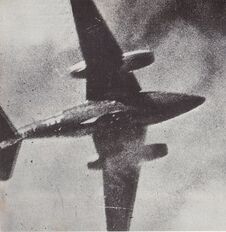The Messerschmitt Me 262 was a single-seat jet fighter that was used by Germany during World War II.
Description[]
The first production model of the series was the Me 262A-0 pre-production model, though the first standard model became the A-1a. The Me 262 was the first operational jet fighter ever and it had dual Junkers Jumo 004 Jet Engines that were capable of propelling the Me 262 at speeds of up to 869 km/h.[1] Armament consisted of four 30mm MK 108 autocannons mounted in the nose and up to twenty-four 55mm R4M anti-air rockets for use against Allied bombers. As a fighter bomber conversion, the 262 could also carry two 250 kilogram bombs underneath the fuselage or one 500 kilogram bomb.
| “ | It was really a lovely aircraft and had many advanced features, great power, and a wonderful visibility forward and all around with the canopy. I really was impressed by the speed and performance, but not so enthusiastic about the inability to turn tightly, or dogfight, as in the 109, which I flew through the entire war and loved very much. -Erich Hartmann, top scoring German ace [2] | ” |
The total weight of the Me 262 was around 3,800 kilograms empty while its total length was around 10.6 meters. Wingspan was 12.4 meters. The 262 had an operational range of around 1,050 kilometers and service ceiling of nerarly 11,500 meters.[3] With a rate of climb of nearly 1,200 meters per minute, it was clear to see how revolutionary the Me 262 design truly was. However, it did have its drawbacks, the engines of the aircraft were known to catch fire if the throttle was put up too quickly and mistakes at low-altitude were quite hazardous. However, the major shortcoming was that the aircraft lacked dive breaks. Furthermore, the Me 262 required a long runway so that it could take off; this later became its enemy when Allied fighters began taking advantage of this and shooting most 262s down on takeoff and landing. For protection, the pilot had saw through a 90mm thick hardened piece of armored glass.
While jet to jet confrontations did not happen between Gloster Meteors and Me 262s on the Western Front, it was noted in a 1945 report by the Allies that the Gloster Meteor, using its lower wing-loading, would be able to outturn the Me 262 in aerial combat as well as have the ability to dive away or keep up with it, something most conventional Allied aircraft could not.
Variants[]
The first variants of the 262 series were the A-1a/U1 and A-1a/U2 prototypes. The U1 had experimented with the armament of two 30mm low velocity MK 108 autocannons, two 20mm autocannons, and two 30mm high velocity MK 103 autocannons. The U2 meanwhile featured a Lichtenstein radar system mounted in the nose of the aircraft. The first variant of the 262 to see service was the A-1a/U3 which featured a wide-array of reconnaissance equipment and was unarmed. The A-1a/U4 was a bomber destroyer conversion with a single 50mm autocannon mounted in the nose. This version got farther along with the creation of two prototypes instead of one, though failed to see combat by the end of the war.

A shotdown Me 262 captured by a P-51 Mustang gun camera
The A-1A was the first model of 262 to be able to mount R4M air-to-air rockets underneath its wings. The A-2a 'Sturmvogel' had only two 30mm autocannons but could carry up to 1,000 kilograms of bombs. The A-4a and A-5a were both reconnaissance versions. The various subtypes of the two seat Me 262B were used for advanced flight training and night fighting. The C-1a and C-2b conversions were 262s modified with additional rocket boosters mounted either in the tail or the wings and were the first to takeoff with both rocket and jet power. However, these two remained prototypes. The final 'variants' are the famed HG II and HG III ideas to create much more streamlined, high speed Me 262s.
History[]
The Messerschmitt Me 262 began development as early as 1939, even before the start of the war. However, low-priority status and issues with the extremely complicated jet engine manufacturing delayed the project severely. However, the aircraft finally took flight with jet engines in July 1942. However, engine problems still roamed over the development, with more engines breaking down than actually functioning. Furthermore, Hitler's insistence that the aircraft be used solely as a fast bomber instead of fighter only further delayed the 262's value even after it reached operational status. However, in July 1944, the aircraft scored its first victory against a Mosquito and then the 262 was finally being used against the ever increasing Allied air raids. It was a success, scoring numerous Bomber in the raids.
However, a few victories could not stop the bombing completely and as such, many of Germany's jet aircraft had to be moved to special underground hangars.[4] As for fighting in the air, 262 pilots often had to master their tactics quickly or die. The standard method was to dive on the bombers from behind and make a fast pass, though the speed at which the 262 moved meant that there was little to no time in which to aim and fire. Adding to the German pilot's troubles, as the war progressed, Mustang pilots began working in specialized teams to attack the jet aircraft and finally began to be effective against them. In total, some 1,430 examples of Messerschmitt Me 262 had been produced during the war.
References[]
- ↑ http://www.wwiivehicles.com/germany/aircraft/fighters/messerschmitt-me-262.asp
- ↑ Heaton, D. Colin. The Me 262 Stormbird. Zenith Press (2012), Page 7
- ↑ http://www.militaryfactory.com/aircraft/detail.asp?aircraft_id=108
- ↑ Dorr, F. Robert. Fighting Hitler's Jets. Zenith Press (2013), Page 154
| ||||||||||||||
